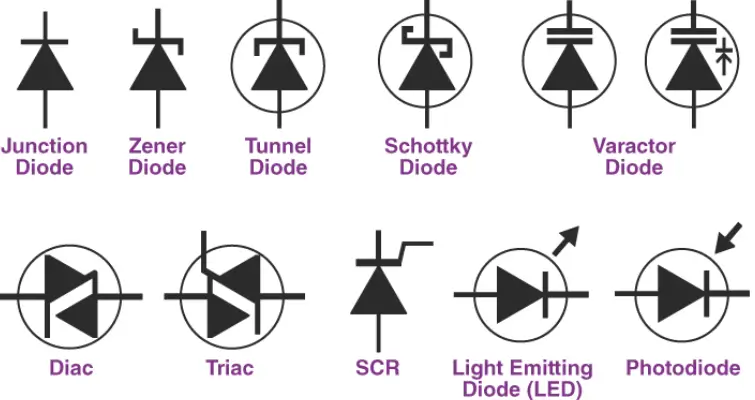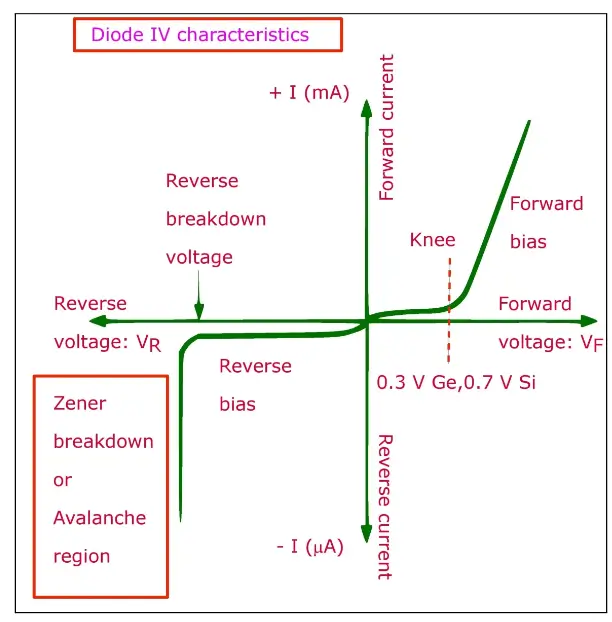Definition of a Diode:
A diode is a semiconductor device that allows current to flow in one direction only, functioning as a one-way switch for electric current. Diodes have two terminals: the anode and the cathode. When the anode is positively biased relative to the cathode, the diode allows current to pass through. Conversely, when the anode is negatively biased, the diode blocks the current.
Types of Diodes:

Diodes come in various types, each serving specific functions:
1. Rectifier Diodes:
- Purpose: Convert alternating current (AC) to direct current (DC).
- Characteristics: High current-carrying capacity.
2. Zener Diodes:
- Purpose: Provide voltage regulation.
- Characteristics: Operate in reverse bias to maintain a stable voltage.
Light Emitting Diodes (LEDs):
- Purpose: Emit light when forward biased.
- Characteristics: Efficient light sources in various colours.
4. Schottky Diodes:
- Purpose: Fast switching applications.
- Characteristics: Low forward voltage drop and fast recovery time.
5. Photodiodes:
- Purpose: Convert light into electrical current.
- Characteristics: Sensitive to light, used in sensors and solar cells.
6. Varactor Diodes:
- Purpose: Act as variable capacitors.
- Characteristics: Used in tuning circuits.
7. Avalanche Diodes:
- Purpose: Operate in high voltage applications.
- Characteristics: Designed to break down and conduct at a specific reverse voltage.
Construction of a Diode:
A typical diode is constructed from a semiconductor material, usually silicon, though germanium and gallium arsenide are also used. The construction involves:
1. P-N Junction:
- P-Type Material: Doped with acceptor impurities, creating holes as the majority carriers.
- N-Type Material: Doped with donor impurities, introducing free electrons as the majority carriers.
2. Formation of the Junction:
- Diffusion Process: The p-type and n-type materials are brought together, allowing electrons and holes to recombine at the junction.
- Depletion Region: A region around the junction becomes devoid of free charge carriers, forming a depletion layer that acts as a barrier to current flow.
3. Contacts:
- Anode: Connected to the p-type material.
- Cathode: Connected to the n-type material.
Working of a Diode:
The operation of a diode depends on the biasing conditions:
1. Forward Bias:
- Connection: Positive terminal of the battery to the anode, negative to the cathode.
- Effect: Reduces the width of the depletion region, allowing current to flow through the diode.
2. Reverse Bias:
- Connection: Positive terminal of the battery to the cathode, negative to the anode.
- Effect: Increases the width of the depletion region, preventing current flow (except for a small leakage current).
IV Characteristics of a Diode:

The current-voltage (IV) characteristics of a diode describe the relationship between the current flowing through the diode and the voltage across its terminals:
1. Forward Bias Region:
- Threshold Voltage (Vth): The minimum forward voltage at which the diode starts to conduct significantly (approximately 0.7V for silicon diodes, 0.3V for germanium diodes).
- Reverse Bias Region
- Reverse Saturation Current (Is): A small current that flows due to minority carriers.
- Breakdown Voltage (VB): At sufficiently high reverse voltage, the diode undergoes breakdown, leading to a large increase in current (avalanche or Zener breakdown depending on the diode type).
2. IV Curve:
- Forward Bias: Exhibits a sharp rise after the threshold voltage.
- Reverse Bias: Shows a small leakage current up to the breakdown voltage, beyond which current increases sharply.
Conclusion:
Diodes are fundamental components in modern electronics, essential for directing current flow, signal modulation, voltage regulation, and light emission. Understanding their types, construction, and operation is crucial for designing and troubleshooting electronic circuits. The IV characteristics provide valuable insights into their behaviour under different electrical conditions, enabling their effective application in various technological fields.




